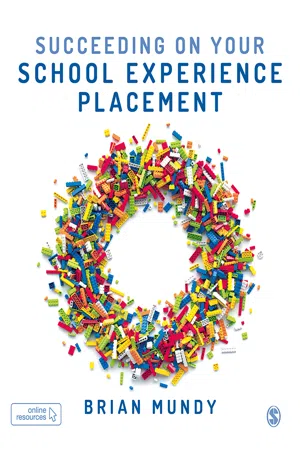
- 312 pages
- English
- ePUB (mobile friendly)
- Available on iOS & Android
Succeeding on your School Experience Placement
About this book
This book is designed to help you through one of the most important aspects of your pre-service teacher education: your school experience placements. Highly practical and accessible, it gives guidance on what happens before, during and after placement, and provide you with strategies on how to deal with the issues that you will encounter in school, including classroom management, lesson planning and catering for individual differences.
Each chapter includes:
· Relevant AITSL standards that are being addressed
· Key terminology that you'll need to familiarise yourself with
· Essential questions that encourage discussion of teaching practice
· Frequently asked questions by pre-service teachers with potential responses
· Placement scenarios that offer valuable learning opportunities
The book is also supported by 30+ downloadable lesson plan and classroom-ready templates.
Frequently asked questions
- Essential is ideal for learners and professionals who enjoy exploring a wide range of subjects. Access the Essential Library with 800,000+ trusted titles and best-sellers across business, personal growth, and the humanities. Includes unlimited reading time and Standard Read Aloud voice.
- Complete: Perfect for advanced learners and researchers needing full, unrestricted access. Unlock 1.4M+ books across hundreds of subjects, including academic and specialized titles. The Complete Plan also includes advanced features like Premium Read Aloud and Research Assistant.
Please note we cannot support devices running on iOS 13 and Android 7 or earlier. Learn more about using the app.
Information
1 Introduction
- 6. Engage in professional learning
- 6.1 Demonstrate an understanding of the role of the Australian Professional Standards for Teachers in identifying professional learning needs
- 6.2 Understand the relevant and appropriate sources of professional learning for teachers.
- 6.4 Demonstrate an understanding of the rationale for continued professional learning and the implications for improved student learning.
Key vocabulary and concepts
Chapter overview

- EQ 1 Why do we have placements?
- EQ 2 What types of placements occur around Australia?
- EQ 3 What is needed to graduate as a pre-service teacher?
- EQ 4 What are the AITSL standards?
- EQ 5 How does placement prepare you for your graduating assessments?
- EQ 6 How can you maximise your learning from placements?
- EQ 7 How can you thrive as well as survive on placement?
EQ 1 Why do we have placements?
An initial teacher education (ITE) program is accredited by demonstrating evidence against the nationally agreed Accreditation Standards and Procedures. All Australian ITE programs are accredited by state and territory teacher regulatory authorities using these nationally agreed Standards and Procedures. (https://www.aitsl.edu.au/deliverite-programs/understand-ite-program-accreditation [2017, accessed May 18, 2020])
EQ 2 What types of placements occur around Australia?
- the numbers of students needing placements at that time
- pre-service teachers not correctly completing their student profiles or similar programs that give the required details for placement
- the difficulty of placing pre-service teachers with a specific specialist requirement such as psychology or a specific Language other than English (LOTE)
- distance
- health problems
EQ 3 What is needed to graduate as a pre-service teacher?
Table of contents
- Cover
- Half Title
- Publisher Note
- Title Page
- Copyright Page
- Contents
- Illustration List
- Table List
- About the author
- Preface
- Acknowledgements
- About the website
- 1 Introduction
- Part A The placement stages
- 2 Pre-placement
- 3 Beginning placement
- 4 The placement experience/completing placement
- 5 Post-placement
- Part B Major placement issues
- 6 Classroom management
- 7 Lesson and unit planning
- 8 Catering for all
- 9 Assessment in the classroom
- 10 Evaluating pedagogy
- 11 Developing theory
- References
- Index